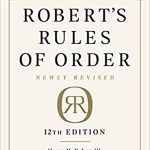Robert’s Rules of Order
Guest post by Nicole Schenk The motion Point of Order is a request to the chair to enforce a parliamentary rule, which a member is claiming has just been broken, or is in the process of being broken. Calling a Point of Order is a basic right of every member. It is one way to…
Read MoreGuest post by Ted Weisgal Brigadier General Henry Martyn Robert was a genius. After a disastrous 14-hour meeting in 1863, he reflected for 13 years and attended lots of meetings. From those experiences as well as research into British parliamentary law and rules of the U.S. House of Representatives, he created what has become the…
Read MoreRobert’s Rules of Order is a daunting subject for many folks who haven’t yet seen how much it improves meetings. We strive in Jurassic Parliament to distill key information that will help you run effective and fair meetings. Distillation is one thing, but ADDING RULES? When there are already hundreds of pages of rules in…
Read MoreIt is a fundamental principle of Robert’s Rules of Order Newly Revised, 12th edition (RONR) that main motions must be taken up at the proper time on the agenda. (A main motion proposes action by the body). This is necessary in order to preserve order, and the rights of members. To that end, RONR establishes…
Read MoreIt seems that a lot of confusion prevails within our local government bodies about the Motion to Reconsider and how to use it. This article describes when and how to reconsider a motion, and other ways of changing your mind as a body. It was first published on the MRSC blog. MRSC is a private…
Read MoreGuest article by Ted Weisgal Are bylaws the be-all and end-all of organizational development? If you create good ones will a flourishing organization be the natural outcome? Probably not. Good bylaws are critically important, but you should also have: A mission that resonates with people, Orderly meetings, Members who are reliable, Agendas that justify people’s…
Read MoreUpdated November 20, 2022 Boards and councils often fail to process reports correctly. When an officer or a committee submits a written report, the board usually should NOT vote to accept, adopt, approve, or receive it. Instead, the report is noted as received for filing. No action is necessary. The minutes simply state: Last month’s…
Read MoreIn Robert’s Rules of Order, a RESOLUTION is a special type of MOTION. My friend the late John Stackpole, a distinguished parliamentarian, described it this way: “A resolution is a motion in fancy dress.” A resolution is used for important or complex questions, or when greater formality is desired. A resolution should be put into…
Read MoreWhen a group of people gather together to conduct their organization’s business, they are in a meeting. The group of people is called an “assembly,” and the event by which they gather is called a “meeting.” Sometimes in order to conduct business the assembly meets in a series of meetings. This series of meetings is…
Read MoreDo you want committees that run smooth and effective meetings? Download our paper, “Committees in Robert’s Rules,” to learn how they can. Committees in Robert’s Rules – Introduction A committee is a group of volunteers who have agreed to do a job defined by someone else. The key fact about a committee is that it…
Read More










